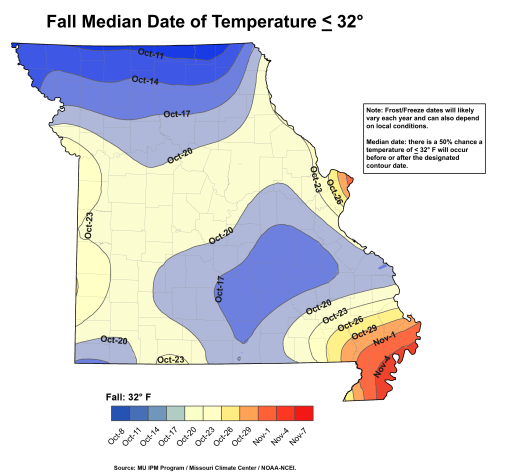COLUMBIA, Mo. – University of Missouri Extension’s Frost/Freeze Probabilities Guide tells us that it’s time to think about protecting plants from frost, said MU Extension state horticulture specialist David Trinklein.
Although near-freezing temperatures are not currently in the forecast, daily temperature normals are dropping and daylight is dwindling, says MU Extension state climatologist Zachary Leasor.
The median dates of frost-freeze probabilities vary by region in Missouri. Based on historical data, northern counties would experience their first frost around Oct. 11. Central Missourians usually see the first freeze around Oct. 20, while the first freeze is around Nov. 1 in the southern part of the state. Frosts are more likely to come earlier over the Ozarks compared to central Missouri due to the Ozarks’ higher elevation.
Not all plants react the same to lower temperatures, Trinklein said. “Certain species, especially tropical ones, suffer ‘chill injury’ at temperatures well above freezing. Most species in this category should not be exposed to temperatures lower than 45 degrees Fahrenheit.”
Since many tropical species are container-grown, they should be brought inside fairly early in the fall, if possible, he said.
“Also, consider that the moisture in plant tissue is not pure water and does not change from liquid to solid at 32 degrees,” Trinklein said. Except for sensitive, tropical plants, most plants can withstand 28 F with little, if any, damage. Cool-season flowers and vegetable can withstand considerably lower temperatures, depending on species and the exposure to gradually cooler conditions.
Trinklein’s philosophy for protecting plants in the fall differs from that for spring. In the fall, gardeners are simply prolonging the inevitable when attempting to protect plants from cold. “Be they ornamentals or food crops, they have served their purpose and provided enjoyment and food for the past growing season,” he said. “However, in the spring, gardeners are protecting an investment they have made in plants that have yet to pay dividends. Therefore, more aggressive (expensive) measures are warranted.”
In either case, protection from cold temperatures involves attempting to preserve latent heat stored in the soil or growing medium of a container. Normally, this involves placing insulating materials over tender plants.
“This process likely will result in only a couple of degrees difference from under the insulative material versus above it,” said Trinklein. Floating row cover is an example of a commercially available product manufactured for frost protection.
Fortunately, there is more latent heat in the soil in the fall than in the spring. Therefore, protecting plants with an insulating material tends to be more successful in the fall. Remove the protective material during the day to expose the plants to sunshine.
Finally, as the growing season comes to an end, Trinklein said, many gardeners will choose to follow the wisdom of “to everything there is a season, and a time to every purpose … A time to plant, and time to pluck up that which is planted.” It is time to prepare for winter and look forward to the next growing season, he said.
The Missouri Frost/Freeze Probabilities Guide uses data from the National Center for Environmental Information and county-level probability tables based on Missouri Mesonet weather station data.
